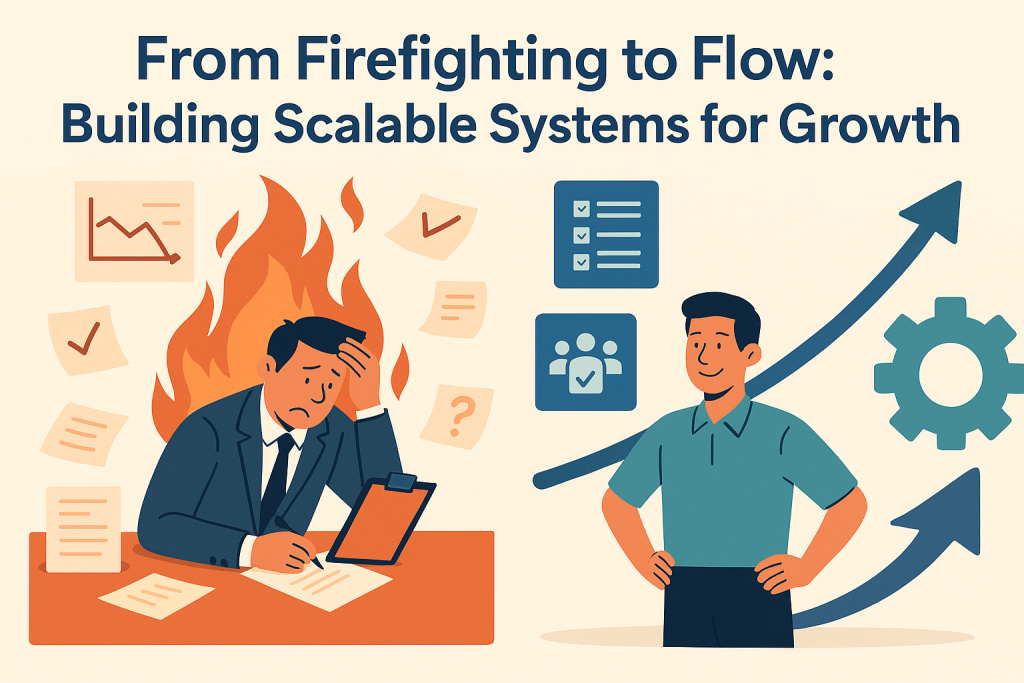If you’re running a mid-market business with 20–40 staff, chances are you’ve felt it: the constant firefighting. Staff chase missed emails, reschedule jobs at the last minute, double-handle data, and scramble to satisfy customers. On the surface, things are “working”—but growth feels harder than it should.
This is a classic symptom of businesses that outgrow their systems. The processes that once supported growth become the very barriers that slow it down. According to McKinsey, companies lose 20–30% of revenue each year due to inefficiencies—a figure that hits hardest when teams are too big for manual management but too small for enterprise overheads.
The good news? You don’t need to scale chaos along with headcount. By investing in scalable systems and automation before the cracks widen, you can move from firefighting to flow—unlocking growth without burning out your team.
Why Firefighting Becomes the Default
1. Reliance on “Tribal Knowledge”
When businesses are small, knowledge lives in people’s heads. At 30 staff, this becomes dangerous. Without standardised processes, information gaps widen, leading to errors, duplicated effort, and unhappy customers.
2. Manual Workarounds
Mid-sized teams often patch gaps with spreadsheets, emails, and endless meetings. These “temporary fixes” quickly become permanent bottlenecks. Research by PwC shows manual data entry consumes 15% of staff time, time that could be spent on revenue-generating work.
3. Lack of Visibility
Owners and managers struggle to see the whole picture. Which projects are profitable? Where is stock stuck? Why do jobs keep running late? Without integrated reporting, leaders are flying blind.
4. Customer Expectations Outpacing Capability
Today’s customers expect instant responses and consistent updates. Salesforce reports that 76% of customers expect consistent engagement across teams. Without automation, mid-market businesses struggle to keep up.
What Flow Looks Like
“Flow” doesn’t mean perfection—it means a business where systems do the heavy lifting, leaving people free to focus on strategy, customers, and growth.
Automated Quote-to-Invoice
When a customer accepts a quote, the invoice generates automatically. Payments trigger stock allocation, courier booking, and customer updates. No rekeying. No missed steps.
Smart Scheduling
Integrated scheduling tools eliminate clashes and enable automated rescheduling. Customers get reminders, staff get visibility, and jobs get done on time.
Standardised Data
Clean, consistent data across CRM, Inventory, and Accounts forms the backbone of automation. It enables accurate reporting, profitability analysis, and forecasting.
Compliance Without the Headache
Automation generates compliance documents, logs approvals, and ensures audit readiness. Instead of last-minute scrambles, compliance becomes seamless.
Customer Journeys That Run Themselves
Branded emails and SMS keep customers informed at every stage—booking, reminders, “we’re on the way,” and post-job follow-ups. Staff don’t have to lift a finger.
Building Scalable Systems: A Phased Roadmap
Businesses that succeed at this stage rarely “rip and replace.” Instead, they adopt a phased roadmap:
- Data First — standardise product codes, customer records, and processes.
- Automate Core Processes — start with quoting, invoicing, and scheduling.
- Enhance Customer Experience — add automated comms and tracking.
- Integrate External Systems — link websites, suppliers, and couriers.
- Leverage Analytics — once data is clean, use dashboards for profitability and forecasting.
This approach delivers value early while building confidence and adoption.
A Real-World Turnaround
A mid-sized manufacturer I consulted with was stuck in firefighting mode. Staff spent hours chasing late orders, updating spreadsheets, and fixing invoicing errors. Morale was sinking, and growth had flatlined.
By introducing scalable systems:
- We automated quote-to-invoice and courier tracking.
- Standardised stock codes across CRM and Inventory.
- Implemented automated customer updates.
- Rolled out profitability dashboards in Zoho Analytics.
Within three months, admin time dropped by 40%, customer complaints fell, and leadership finally had visibility into margins. Growth resumed—without adding headcount.
The Bottom Line
At 20–40 staff, the difference between stagnation and scale often comes down to systems. Keep firefighting, and growth will stall. Build scalable systems, and your business can flow—streamlined, predictable, and ready for the next stage of growth.
The best time to act is before the cracks widen. The second-best time is now.

